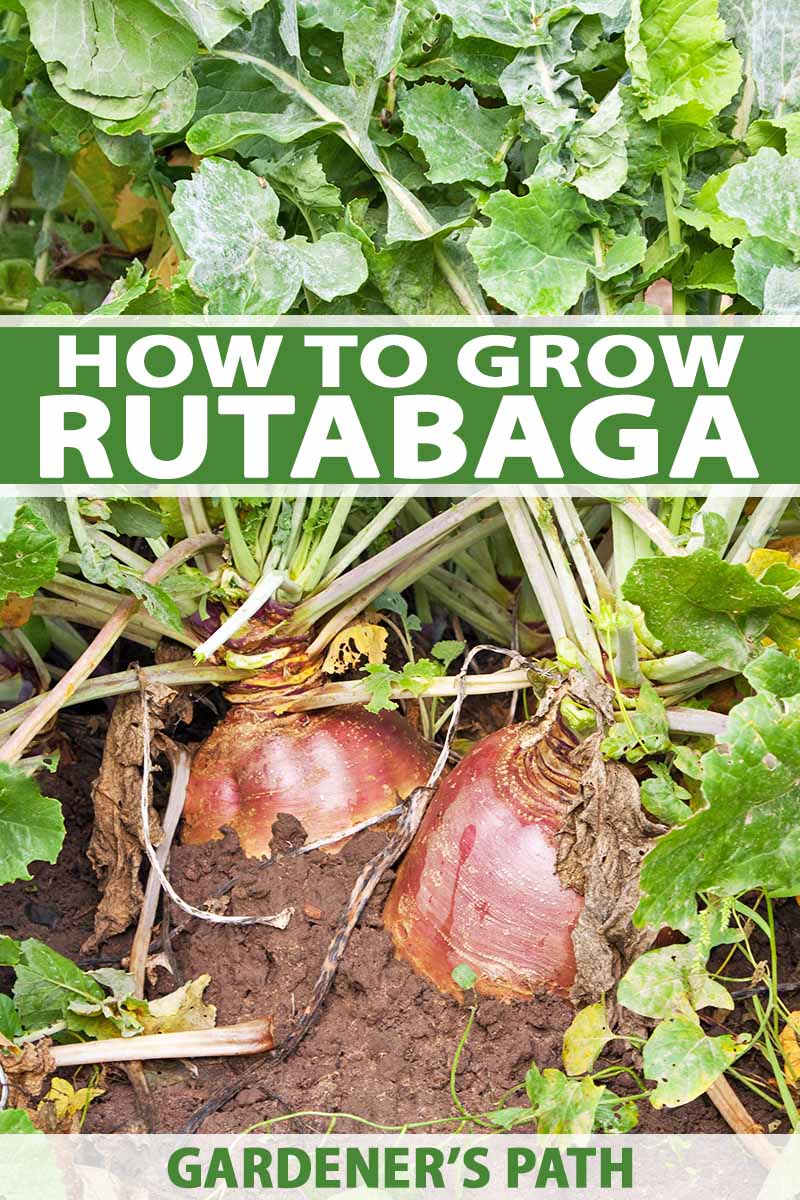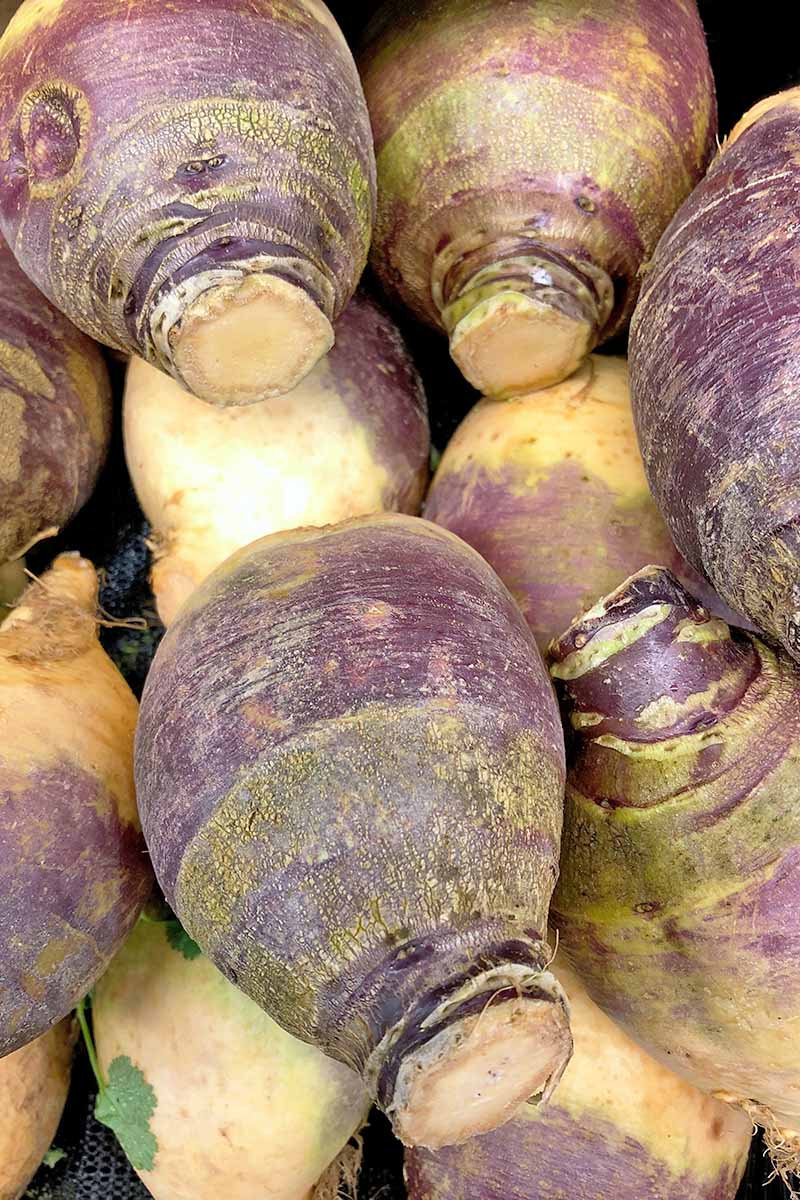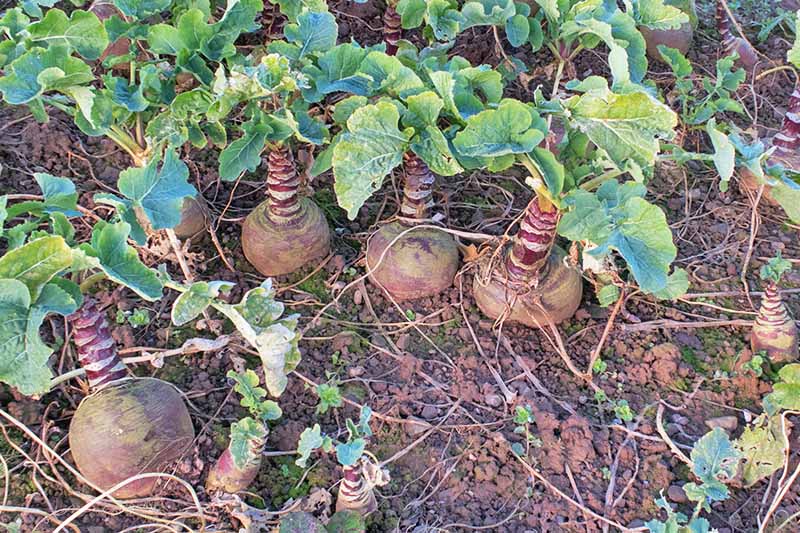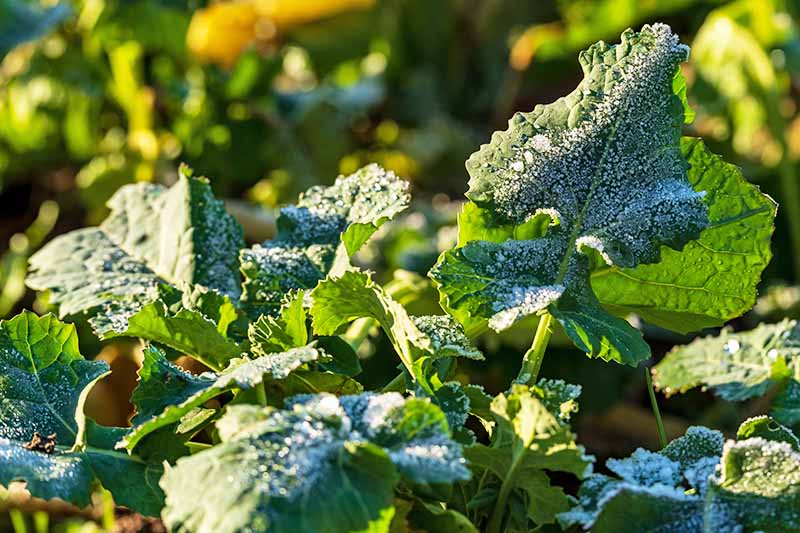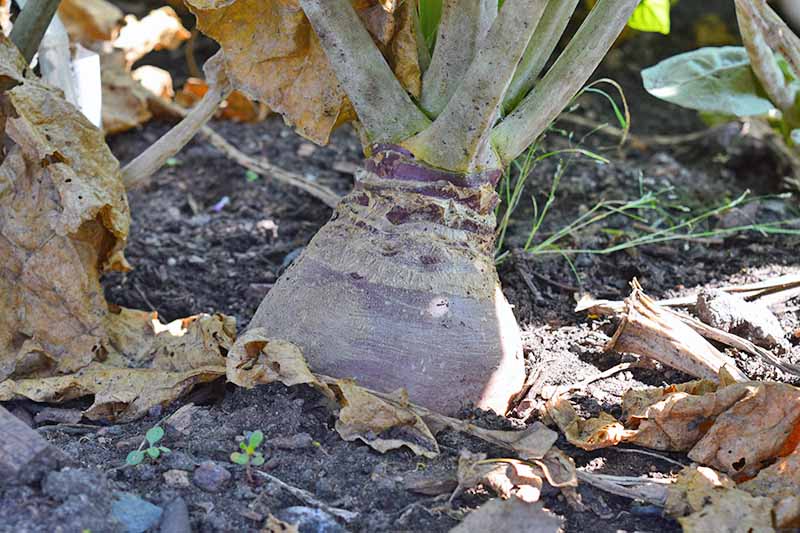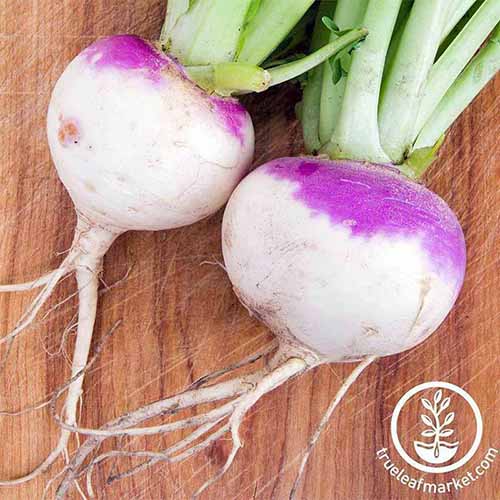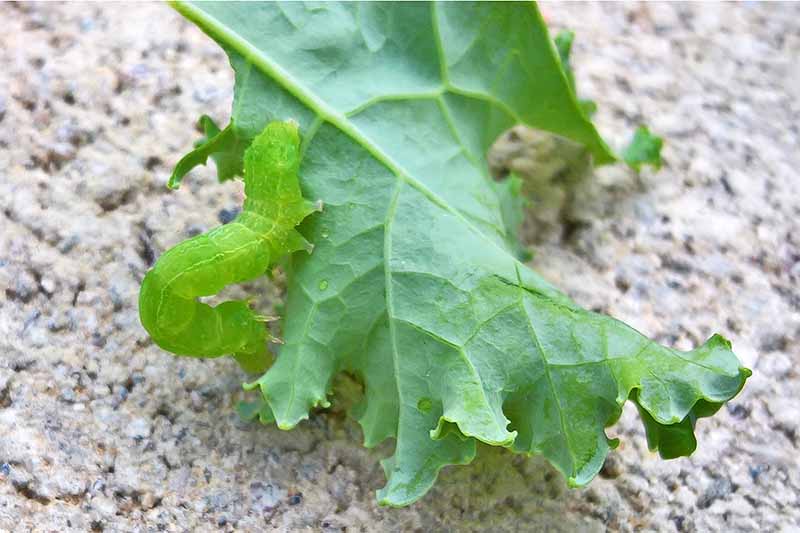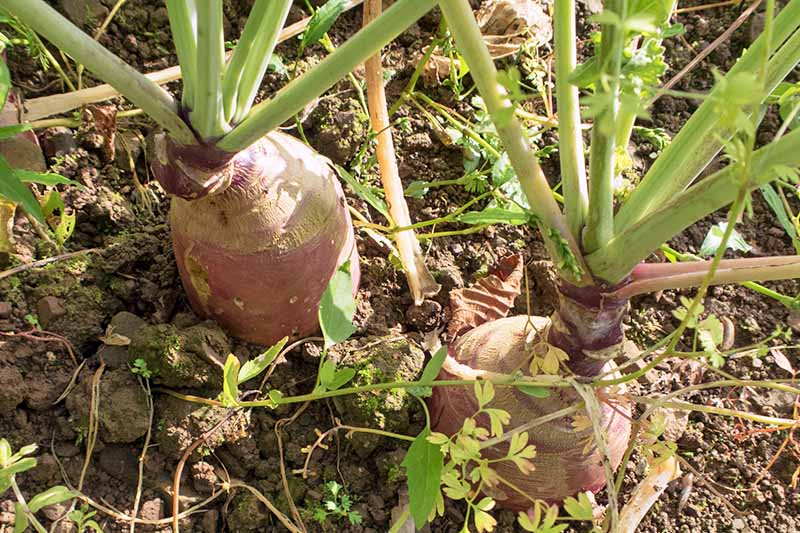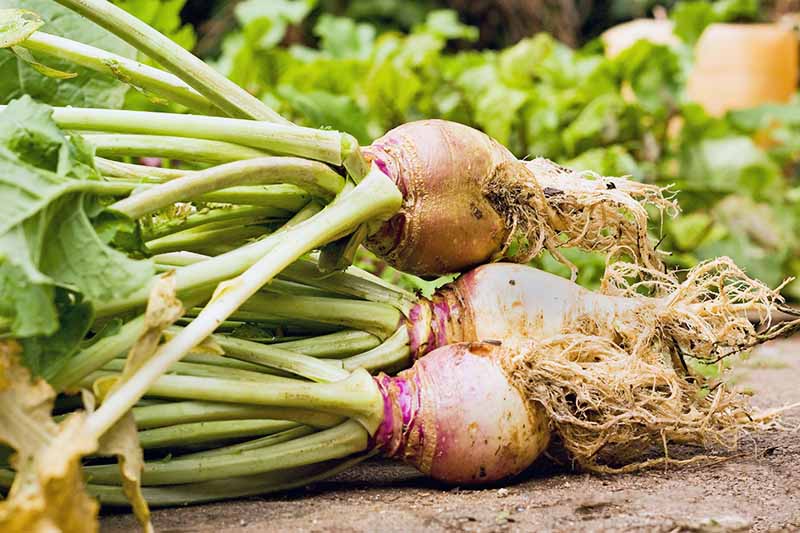We link to vendors to help you find relevant products. If you buy from one of our links, we may earn a commission.
What Is Rutabaga?
Also known as Swedish turnip, fall turnip, or simply a Swede, this under-appreciated cross between a turnip and a cabbage is a great addition to any autumn garden! Rutabagas are brassicas, similar to turnips, but they have a sweeter flavor, larger roots with golden flesh, purple and yellow-tinged skin, and smooth, waxy foliage.
The roots, which are high in fiber but low in calories, can be eaten raw or cooked, similar to other root vegetables. They can be mashed, roasted, sauteed, fried, added to soups, and even eaten raw in salads or coleslaw. The early leafy greens are also edible and can be eaten in salads or cooked. Rutabagas are extremely nutritious veggies. They are high in minerals including potassium, magnesium, calcium, iron, and zinc, as well as vitamin C, which offers benefits to the immune system.
They also contain glucosinolates, antioxidant compounds which have been found to reduce the growth of cancer tumors in vitro. They can be a good source of protein for vegetarians as well – one medium root contains 8% of the recommended daily value. They can also be a useful alternative to potatoes for diabetics, as they have a lower glycemic index.
Cultivation and History
Thought to have originated in Scandinavia around the 1400s, rutabaga was first grown as animal feed, though it didn’t take long for humans to discover the delights of this sweet and nutty root veggie. It was introduced in England around the early nineteenth century, and it likely arrived in North America around that time as well. It is now commonly grown in the Northern US, Canada, and Northern Europe, as it has an affinity for cool northern soils. These days, rutabagas are a cause for celebration in some farming communities around the country.
The city of Askov, Minnesota, which had a population of 364 in 2010, is known as the rutabaga capital of the world. It was founded by Danish immigrants in 1906, and for many years the majority of America’s rutabagas were grown here. The city still celebrates its rutabaga pride in an annual festival, which has been celebrated for over 100 years. At the festival, you can feast on such delicacies as rutabaga sausage and malts. The town of Cumberland, Wisconsin also hosts a rutabaga festival each year. The tradition, which began in 1932, takes place over several days every August and includes a parade, live music, a pepper-eating contest, a tractor pull, and of course, rutabagas!
Propagation
Want to become part of the fun? The good news is that this vegetable is very easy to grow. It is best sown in place as this crop does not transplant well. Do not attempt to start rutabaga indoors or in a greenhouse.
For planting depth, follow the instructions on the seed packet. Generally, seeds should be sown at a depth of 1/2 inch, or 1/4 inch for early spring plantings. Rake and aerate the soil, plant seeds every few inches in rows, and then thin to six inches apart when seedlings are a few inches high. Rows should be spaced two feet apart. You can also choose to broadcast and rake seeds into a bed of soil and thin later to give each plant 6 inches of room to grow. Full sized rutabaga roots can grow fairly large, about the size of a grapefruit. Soil needs to be 40 degrees for germination, which can take one to two weeks.
How to Grow
As a cool weather crop, plantings should be timed for harvest in late autumn, or even through the winter in warmer climates. Leaves can be harvested and eaten when young, but roots take approximately 90 days to mature, and they become tastier and more tender after the first or second frost. Rutabaga should be planted in early to mid-summer depending on your zone, generally about three months before the first expected frost date. In warmer southern climates where the ground doesn’t freeze solid, it is also possible to plant before the last frost date in early spring for a first round. But keep in mind that hot weather can make roots taste bitter and woody.
At my home in Vermont (USDA Hardiness Zone 4b) I plant rutabaga in mid-June, just as my spring greens are wrapping up the season. Find a site in full sun or partial shade. It does not need heavily fertile soil, but does require a neutral pH and loose, well drained soil that retains moisture. Though not heavy feeders, it is always a great idea to amend soil with organic materials such as composted manure before planting, which will increase the health of the soil and the size of your crop. If your soil is on the acidic side, mix some wood ash into your soil just before planting to lower the acidity. While you are waiting patiently for the tasty roots to mature, be sure to weed regularly and water well!
Water is the key to a successful rutabaga crop. This plant prefers constant and consistent moisture for a tender, well-flavored crop. Dry soil will change the taste of the root, causing it to be fibrous and forcing the plant to send up seed stalks. Additionally, when the soil changes dramatically from wet to dry, the roots can split. Watering is most important as the roots are maturing.
Growing Tips
Consider rotating with plants that are heavier feeders, such as squash or corn. Do not plant near other brassicas, such as kale or cabbage. Avoid planting near mustard greens, which can inhibit growth. Excellent companion plant to onions or climbing peas. Use drip irrigation to ensure that the soil stays consistently and evenly moist, but not waterlogged. Mulch heavily when leaves are a few inches tall, to help retain moisture, keep down weeds, and prevent frost damage. Harvest just after first frost for superb flavor.
Managing Pests and Disease
Insects
Primary pests are similar to those that plague other brassicas.
‘American Purple Top’ Rutabaga Seeds Seeds are available from True Leaf Market.
Cabbage Loopers
These pesky green caterpillars hang out on the leaves, munching their way through the foliage. The adult moths lay tiny eggs on and under leaves.
I pick off cabbage loopers by hand whenever I see them. Infestations can spread rapidly, so keep an eye on your plants! If the situation gets out of control, diatomaceous earth and Bacillus thuringiensis (Bt) also work well to control cabbage loopers. Read more about fighting cabbage looper infestations here.
Root Maggots
These little white pests live in the soil and feed on the roots of a variety of crops. It is often difficult to spot an infestation until it is too late. Look for tunnels or holes in roots and yellowing of the leaves. Diatomaceous earth sprinkled around seedlings or introduction of natural predators can be beneficial, though in general, prevention is the best remedy. Rotate crops regularly, add row covers, and promptly remove any plants that show signs of infestation. Sprinkling wood ash along the rows can also help to prevent root maggot infestation by preventing the adult flies from laying eggs on the soil. Read more about controlling cabbage root maggots here.
Other Pests
Aphids, slugs, and flea beetles can be a problem as well. Regular hand picking of insects and spraying steadily with a hose can prevent an infestation. Row covers can be an effective deterrent, but crop rotation and healthy soil are key. Do not plant near other brassicas (such as kale or cabbage) as they are susceptible to the same diseases and pests. Incorporating plants that attract beneficial insects can also be a great way to help control pests. Read more about rutabaga pests here.
Diseases
Though not exceptionally prone to disease, there are a few issues that may occur if crops are not rotated on a regular basis or if soil is too acidic. Clubroot and root knot are two common problems that can cause deformation of roots, and both can be prevented by strict crop rotation. Clubroot in particular can live in soil for 20 years. Just be sure not to plant in beds known to have been affected in the past, or anywhere other brassicas have grown in the last five years. Additionally, it is important to remove diseased plants immediately to keep disease from spreading. Click here for more information on diseases affecting rutabagas.
Harvesting
Harvest about 90 days after planting, or around the first or second frost as the flavor is improved with cold weather.
Try cooking up some of these tasty roots upon harvest, and store the rest for later. Rutabaga has excellent storage potential – it can be stored for up to a year! Read our complete harvesting and storing guide here.
Rutabaga Quick Reference Growing Guide
Depending on your climate, there may still be time to plant a rutabaga patch this year to be ready for a Halloween harvest. Just be sure to send us pictures of your rutabaga jack-o’-lantern in the comments below! You can read more about growing root crops with some of these guides:
How to Plant and Grow Turnips Planting Parsnips: One Taste and You’ll Want to Grow Your Own Planting Beets: A Crop for Cooler Seasons
© Ask the Experts, LLC. ALL RIGHTS RESERVED. See our TOS for more details. Product photo via True Leaf Market. Uncredited photos: Shutterstock.

